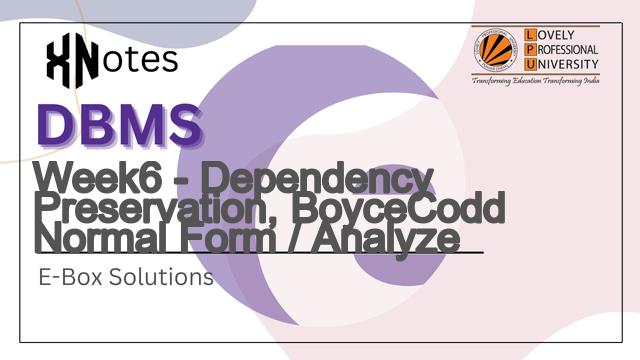Week6 - Dependency Preservation, BoyceCodd Normal Form / Analyze | E-BOX DBMS

Week6 - Dependency Preservation, BoyceCodd Normal Form / Analyze
The questions can come in any order, so make sure you are selecting right option for all questions.
1. A table is in BCNF if it is in 3NF and if every determinant is a ___________ key.
(c) Super
2. R is decomposed or divided into R1 with FD { f1 } and R2 with { f2 }, then the decomposition is not dependency preserving when
(b) f1 U f2 is a subset of F
3. What does BCNF stand for in Database Normalization?
(b) Boyce–Codd Normal Form
4. Consider the relation R (X,Y,W,Z,P,Q) and the set F = {XY -> W, XW -> P, PQ -> Z, XY -> Q}.
R is decomposed into R1(Z,P,Q) and R2(X,Y,W,P,Q).
Which of the following is true about R?
(d) Both lossless decomposition and dependency preserving decomposition
5. Consider the student database, in which data of the student are mentioned.
| Stu_ID | Stu_Branch | Stu_Course | Branch_Number | Stu_Course_No |
|---|---|---|---|---|
| 101 | Computer Science & Engineering | DBMS | B_001 | 201 |
| 101 | Computer Science & Engineering | Computer Networks | B_001 | 202 |
| 102 | Electronics & Communication Engineering | VLSI Technology | B_003 | 401 |
| 102 | Electronics & Communication Engineering | Mobile Communication | B_003 | 402 |
Answer the following questions
Question 1
What are the candidate keys of the original table?
(d) {Stu_ID, Stu_Course}
Question 2
Why is the table not in BCNF?
(c) Neither Stu_ID nor Stu_Course is a superkey.
6. R(A,B,C,D) is a relation. Which of the following does not have a lossless join, dependency preserving BCNF decomposition?
(c) AB->C, C->AD
7. Let R (A, B, C, D) be a relational schema with the following functional dependencies:
A → B, B → C,
C → D and D → B.
The decomposition of R into
(A, B), (B, C), (B, D)
(a) gives a lossless join, and is dependency preserving
8. R is decomposed or divided into R1 with FD { f1 } and R2 with { f2 }, then the decomposition is dependency preserving when
(a) f1 U f2 = F
9. Which of the following is NOT a rule for BCNF?
(c) All attributes should be atomic.
10. Consider the relation R (X,Y,Z,W) and the set F = {X -> Y, W -> Z}.
R is decomposed into R1(X,Y) and R2(Z,W).
Which of the following is true about R?
(b) Dependency preserving but not lossless join